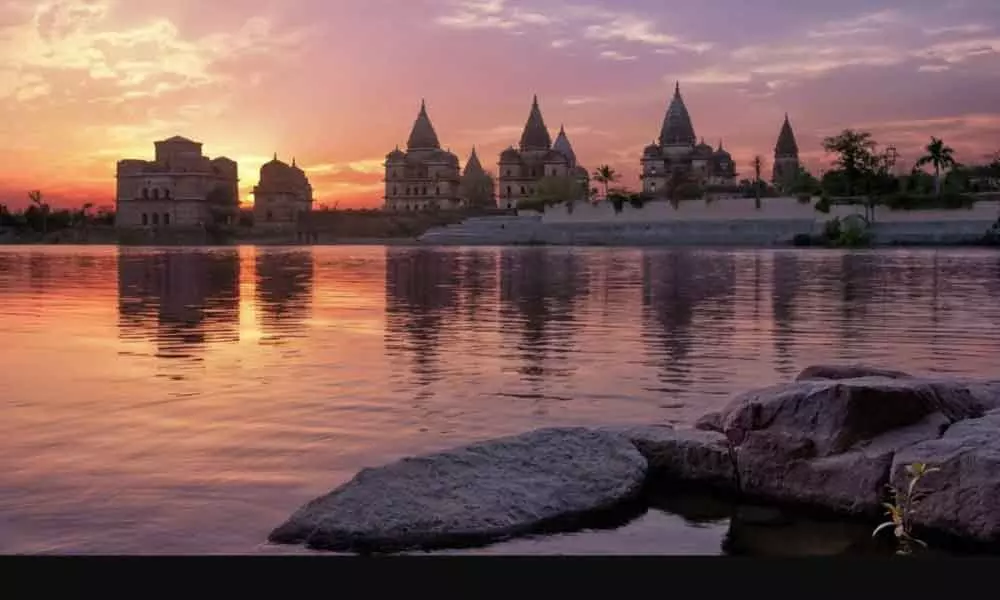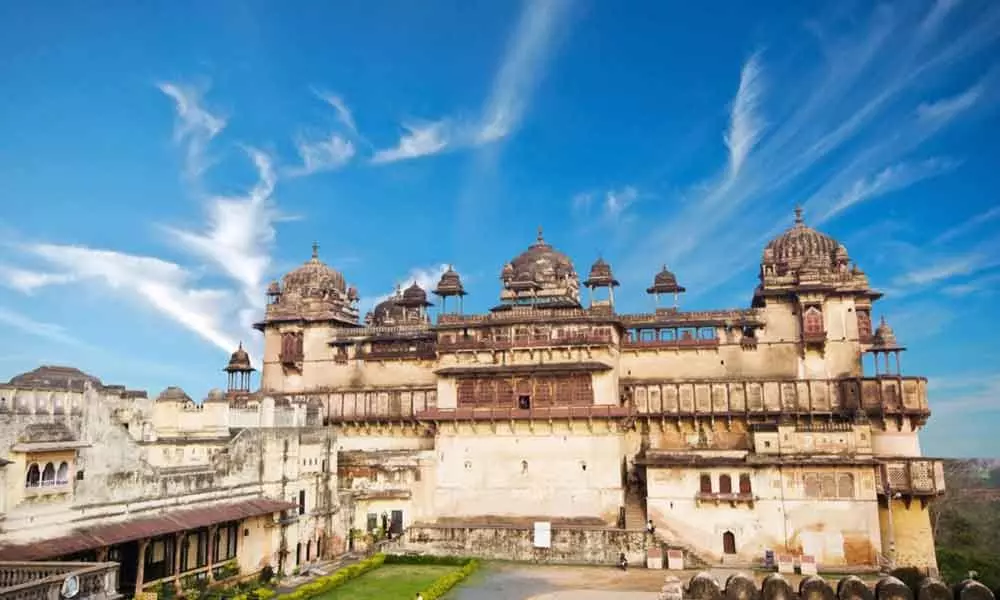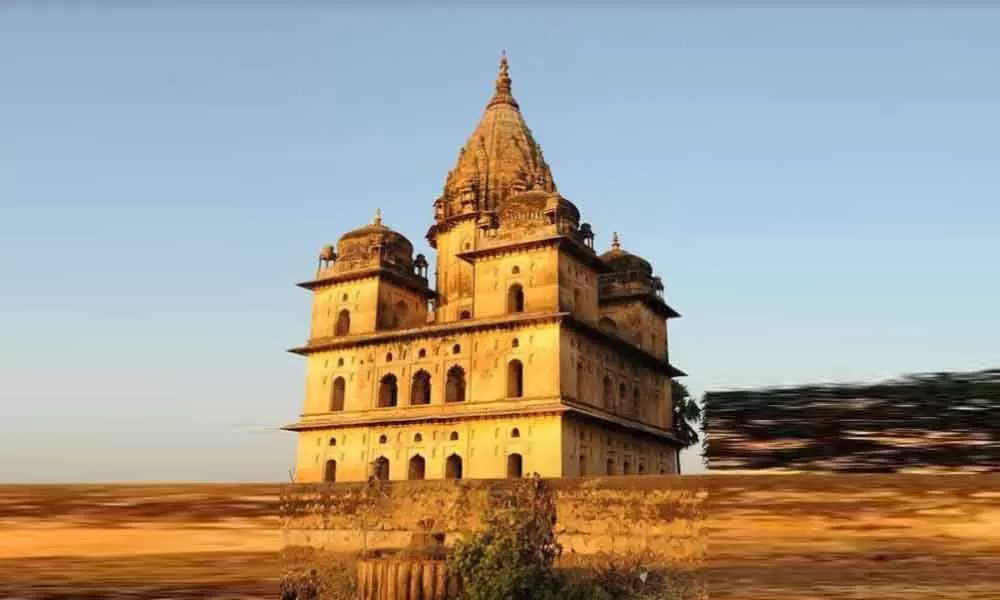Live
- US Navy shoots down own jets over Red Sea
- Nara Devansh sets world record in chess
- Team India cross their fingers
- 3 energy efficient projects to reduce power bills in AP
- Governor Jishnu Dev Varma to Attend ABVP 43rd State Conference in Siddipet Today
- Transgenders to Begin Traffic Assistant Duties in Hyderabad from Tomorrow
- Police Security Tightened at Allu Arjun’s Residence After OU JAC Vandalism
- ED Likely to Issue Notices to BRS Working President KTR Today
- CM Chandrababu Naidu to Attend Christmas Celebrations in Amaravati Today
- CM Revanth to Review Projects with Senior Officials Today
Just In
Orchha: Capital of the Bundela kings

Orchha, the capital of the Bundela dynasty, now part of Madhya Pradesh, lies 124 km from Gwalior. By road, it can be reached in a little more than 3 hours, including a 10-minute break for tea and 'kachoris'. Along both sides of the road, visitors can enjoy the picturesque view of mustard fields and villages. Almost before you know it, the spectacular monuments of Orchha are silhouetted against the sky.
Orchha is a complex of well-preserved palaces and temples and certainly worth a visit. Unfortunately, tour groups are known to do a hurried visit without experiencing the romance of its legends and mysteries.
As one crosses an old stone bridge, there is a winding road leading to a great flat courtyard, while ahead rises the huge Sheesh Mahal, flanked on the left side by the Raj Mahal Palace and the Jahangir Mahal on the right. This huge palace built for royal visitors, now welcomes today's guests, as it has been converted into a hotel. From its rooms in its upper storey, guests can get a scenic view of this ancient town.
Orchha was founded in 1501 AD by the Bundela chief Rudra Pratap Singh, the first king who ruled until 1513. During his reign, he built a Fort at what is now the town of Orchha, located on the banks of the River Betwa. Rudra Prasad Singh was succeeded by his son Bharti Chand, who died in 1554, without leaving an heir. He was succeeded by his younger brother Madhukar Shah. Both Bharati Chand and Madhukar had to deal with attacks, organised under Sher Shah Suri (1545-53) and Emperor Akbar (1556-1605). Madhukar's position, in fact, became so precarious that he had to relinquish his domain to Akbar in the 1570s and agreed to enlist himself and his family in the service of the Mughals.
Orchha's golden age was during the first half of the 17th century, when Mughal emperor Jehangir visited the city. Its architecture, a combination of Rajasthani, Jain and Mughal styles, is now referred to as the 'Bundela Style' of architecture. It seems unbelievable that Vir Singh Deo, who built the Jahangir Mahal in 1605, should have built this splendid palace, just for Jahangir, who stayed as a guest of the Raja for only one night! It is
perhaps because of such actions that he is considered as the most famous and powerful of the Orchha's rulers -- a dashing personality, a great warrior and a wily and clever administrator.
Raja Vir Singh Deo, himself lived in the sprawling Raj Mahal, where the architectural style was simpler than that of the Jahangir Mahal. However, to compensate, there are a number of unique murals, particularly in the bed chambers worth seeing. Many of these rooms are kept under lock and key and not easily accessible. But with a bit of persistence one might be able to cajole the guards to allow visitors a glimpse inside.
The Rai Praveen Mahal, brings us to the legendary romance between the beautiful courtesan Rai Praveen and Raja Indrajit of Bundelkhand – a story that has been recorded by Keshav Das , a poet of that era. The story goes that Emperor Akbar was so smitten by Rai Praveen's beauty, that he wanted her in his harem, against the wishes of the King. It is said that the courtesan was sent to Akbar, but managed to return 'untainted' by asking the emperor a question – "Scavengers, dogs and crows dine on the leftovers of others, to which of these categories my Emperor, do you belong to?" A stumped, Akbar had no option but to send Rai Praveen back to Indrajit.
The Rai Parveen Mahal is a smaller palace with its own garden. Obviously built with love and care, even in its somewhat dilapidated state its graceful arches have a charm, missing in the larger palaces. Reputed to have been exceedingly beautiful and an accomplished dancer, singer and poet, this is where Rai Praveen entertained her beloved. The walled Phool Bagh, remains a cool summer retreat and a place to sit and ponder on the colourful history of Orchha.
There are also some impressive temples to visit, dating back to the 17th Century. These are still in use today and are visited regularly by thousands of devotees. In the centre of the new city, is the Ram Raja Temple with its soaring spires. Originally a palace, it was turned into a temple when an image of Ram, temporarily installed, proved impossible to be moved. This image was however later moved to the nearby Chaturbhuj Temple, where it lies behind silver doors, periodically opened for "darshan". The Lakshmi Narayan Temple has well-preserved murals and is a very popular place of worship.
One must also mention the ornate Chatris (memorials) of the Bundelkhand rulers that are built along the banks of the Betwa. At sunset, it is the silhouetted spires of these Chatris that one will remember most …. when thinking of Orchha.

© 2024 Hyderabad Media House Limited/The Hans India. All rights reserved. Powered by hocalwire.com









